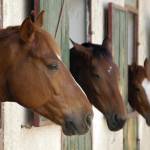From Horse Pasture to Stall

A horse’s life can be quite different depending on whether he is kept in a stall or turned out on pasture. How significant is this difference to his health?
A study in England looked at the effect on eight horses that went from pastured to stalled management. The horses were monitored during a week of turnout and then were brought into stalls where they were fed hay and exercised daily. Water intake, fecal output, and fecal dry matter were measured for the horses at pasture, daily for the first week of stalling, and then every other day for an additional week. Motility of the hindgut was also measured twice a day at several locations by means of ultrasound.
On the second day of stabling, frequency of intestinal contractions was significantly decreased in all regions of the large colon and at the pelvic flexure on the fifth day. Water intake was significantly increased but fecal output was significantly decreased especially in the first week but continuing into the second week of stalling.
The researchers mentioned the inverse relationship between liquid consumed and feces passed, noting a possible increased risk of impaction colic for horses that are moved from turnout to stalls.
The abrupt change from free exercise to limited exercise, coupled with the change from grass to dry hay, might be more safely accomplished by using increasingly longer stalled periods over a span of four to seven days, if possible.








